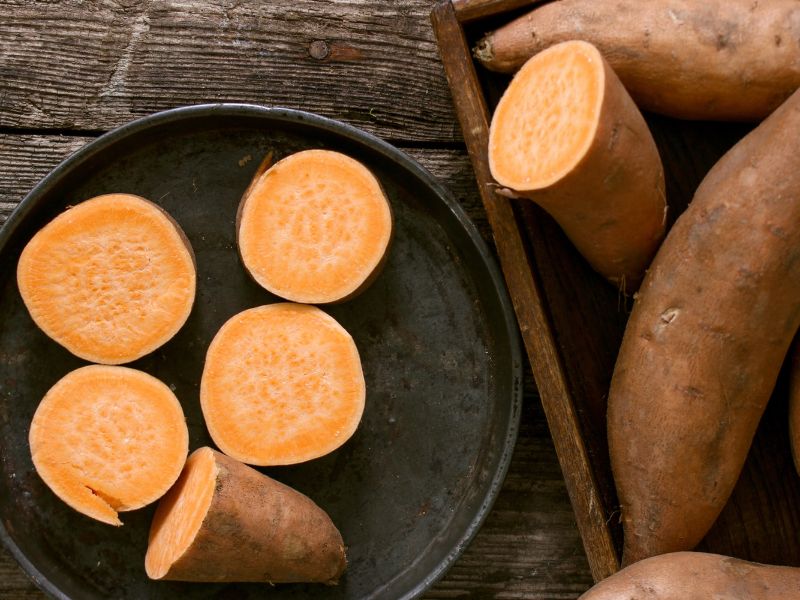Have you ever peeled or cut a sweet potato only to find it turning black shortly after? This can be concerning, but this happens for a few reasons.
But don’t worry — you can take a few easy steps to stop sweet potatoes from turning black. One way is to soak them up in cold water.

Here’s how to keep your sweet potatoes fresh and yummy every time!

How to Stop Your Sweet Potatoes from Turning Black
Why Turning Black?
Here are some possible explanations:
- Oxidation: When the flesh of a sweet potato is exposed to air, it can turn brown or black due to oxidation. This is a natural process that occurs when enzymes in the potato react with oxygen.
- Bruising: Sweet potatoes can become bruised during harvesting, transportation, or storage. These bruises may not be visible on the outside of the potato, but they can cause black spots or streaks inside.
- Mold or bacteria: If a sweet potato has been damaged in some way (such as by cuts or punctures), mold spores or bacteria may enter and cause dark spots to form.
How to Store Peeled or Cut Raw Sweet Potatoes?
Step 1: Peel Your Sweet Potatoes
First, when peeling sweet potatoes, use a sharp knife and move quickly. The longer the potato is exposed to air, the more likely it is to oxidize and turn black.
Step 2: Keep Them Submerged in Water
Once you’ve peeled your sweet potatoes, keeping them submerged in water while stored in the fridge is essential. This helps slow the oxidation process, which causes peeled sweet potatoes to turn black.
Add lemon juice, white vinegar, or salt to the water. This will help keep your potatoes looking bright and vibrant.
Change the water every day or two to stay clean and oxygen-rich.
Step 3: Cook Immediately After Peeling
If possible, try to cook your peeled sweet potatoes immediately after peeling them — this will help ensure that they stay fresh for extended periods without losing their color or flavor.
If life gets in the way and you need extra time before cooking, follow steps 1 & 2 above, and your potatoes should stay good for up to two weeks!
How to Use Browned Sweet Potatoes
Reasons to not throw them away
If you have browned or blackened sweet potatoes, don’t throw them away!
- Browned or blackened sweet potatoes are still safe to eat if they don’t have mold or a foul smell.
- They may have a slightly different texture or flavor, but this can add depth and complexity to your dishes.
Creative ways to use them
- Roast them: Toss the potato chunks with olive oil, salt, and spices like cumin or paprika. Roast in the oven until crispy and caramelized.
- Mash them: Use a fork or potato masher to mash the potatoes with butter, milk, and spices like cinnamon or nutmeg. Serve as a side dish or as a filling for pies or turnovers.
- Blend them: Add to smoothies for added nutrition and sweetness. You can also blend them into soups for added creaminess.

How to Store Fresh Sweet Potatoes?
Whether you’re roasting, mashing, or using them in a soup or stew, it’s essential to know how to store sweet potatoes properly so they stay fresh and flavorful for as long as possible.
Store in a Cool, Dark Place
The best place to store sweet potatoes is in a cool, dark area with good ventilation. This could be your pantry, a kitchen cabinet, or even a basement. Avoid storing sweet potatoes near a heat source like the stove or oven, as this can cause them to spoil more quickly.
Use a Paper Bag or Basket
Instead of storing sweet potatoes loose on a shelf or in a drawer, keeping them in a paper bag or basket is best. This will help protect them from light and moisture while allowing air circulation.
Don’t Refrigerate
While some sources suggest refrigerating sweet potatoes to extend their shelf life, others advise against it. Refrigeration can cause sweet potatoes to develop an off-flavor and become mushy. Instead, stick with room temperature storage for the best results.
These simple tips ensure your fresh sweet potatoes stay delicious and nutritious for weeks.
About Sweet Potatoes
Sweet potatoes are a popular root vegetable that is delicious and packed with nutrients. They belong to the morning glory family and are native to Central and South America.
Nowadays, they are grown in many parts of the world, including the United States, where North Carolina is the largest producer.
Nutritional Benefits
Sweet potatoes are an excellent source of fiber, vitamins, and minerals. They contain high levels of beta-carotene, converted into vitamin A in the body. Vitamin A is essential for maintaining healthy vision, skin, and immune function.
In addition to vitamin A, they contain vitamin C, potassium, manganese, and copper. They are also rich in antioxidants that help protect your body from damage caused by free radicals.
Ways to Enjoy
There are many ways to enjoy sweet potatoes. One popular method is baking them in the oven until they are tender and crispy. You can also roast them with other vegetables or use them as a base for soups and stews.
If you’re looking for some inspiration on how to cook with sweet potatoes, check out these recipes:
- Perfect Baked Sweet Potato by Delish: This recipe shows how to make a perfectly baked sweet potato with just a few simple ingredients.
- Coconut Curry Sweet Potato Soup Recipe by NYT Cooking: This flavorful soup combines sweet potatoes with coconut milk and curry spices for a warming meal.
- Ground Turkey Skillet with Sweet Potatoes and Black Beans by Skinnytaste: This one-pan meal is perfect for busy weeknights and combines ground turkey with sweet potatoes and black beans for a nutritious dinner.

FAQs
Why do sweet potatoes turn black, and can they still be eaten?
Sweet potatoes turn black due to oxidation, which occurs when the flesh is exposed to air. While the discoloration may look unappetizing, it does not mean the sweet potato is spoiled or unsafe to eat. Simply cut away any discolored portions before cooking.
Can I store cooked sweet potatoes without them turning black?
Yes, cooked sweet potatoes can be stored in an airtight container in the refrigerator for up to 4 days without turning black. To prevent moisture buildup and spoilage, ensure they are completely cooled before storing, and don’t stack them too tightly together.












